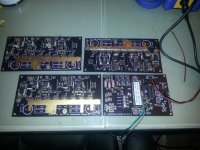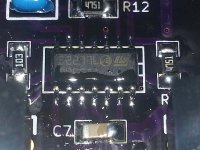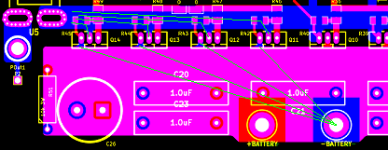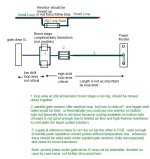OK everyone, I have finally made some HUGE progress. It's not running yet, but it's getting really close now. Virtually all components are installed on the board. I have yet to install the FETs and the gate drive resistors. I need to come up with a cabling system next so I can connect all this stuff together.
Here is a picture of what I have so far. I started building up the trace on the one board. It will have 2 parallel strands of 10 AWG. I need to order the aluminum bar stock for my heat sink, but I can't really do that until I can find a case that I know I'm going to be able to fit this beast in, that's going to be a challenge for sure. I am thinking this will live the majority of it's life as an open frame experiment and I'll use a redesigned one to power my bicycle. I'm pretty much committed to going SMD for all my future work. I just found some cheap 0805/1205 sized resistor and capacitor kits on ebay for a great price. I could have saved myself some money had I already had them on hand.
I really really hope that after all of this work, I am able to get this working... aka I didn't mess up my schematic and therefore my layout.

This is one of the TD350E drivers I soldered. I haven't cleaned off the flux yet since I'm not done with the board, but this should give you an idea of how the chip looks. Sadly the SO-14 package is by far the cleanest solder joint on the entire board

I started building before I had a good station. At least the most critical part looks pretty.

I just purchased two isolated 24V 20A supplied from a forum member here so I can run a 48V, 20A setup (can peak to 40A) without having to use batteries while doing initial testing. I am a wee bit scared to setup some high power LiPo and use it inside on a beta setup, I've been known to make mistakes and would prefer not to lose a pack

Not a lot to start off with, but it will certainly make me feel a bit safer. Maybe if I can get this working well I can work with Arlo1 and have him scope and test it on Colossus to see how it does under a real load.






